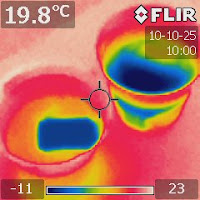 |
| Figure 1. An IR image of a freshwater cup and a saltwater cup after an ice cube was added to each. |
Will an ice cube melt faster in freshwater or saltwater? Why do we salt the road in water? How does an iceberg melt and how might it affect the ocean currents? All these curious questions are wonderful for students to explore. And they are very easy to do.
 |
| Figure 2. An IR image take after four minutes showing the convection in the freshwater cup. |
They are not obvious at first glance and often can be counterintuitive. If you search “ice melts slowly in saltwater” in Google, you can find a lot of discussions and debates. Many students and teachers were confused by what they observed in such a simple system as an ice cube floating in a cup of saltwater. Most of the discussions were, however, merely theoretical.
Obviously, ice molt faster in freshwater because cold molten water can sink to the bottom and warmer water at the bottom is pushed to rise. This process, called convection, runs continuously to carry heat from the whole cup to melt the ice cube.
 |
| Figure 3. An IR image taken after nine minutes showing the cooling effect at the bottom as indicated by the greenish halo. |
In the case of saltwater, the cold water just sat at the top. The only explanation of this is that saltwater is denser so molten freshwater from the ice cube cannot sink, even if it is colder. Somehow, saltwater provides greater buoyancy.
Figure 4 shows that sixteen minutes later, the cold front still had not reached the bottom. This means that not only convection slowed down but also conduction was very slow.
 |
| Figure 4. 16 minutes later… |
Recall our finding that a cup of saturated saltwater can spontaneously develop a temperature gradient from bottom up. This experiment provides a direct evidence that supports the theory that the temperature gradient can be created by the salinity. However, this evidence is not decisive, as the phenomenon reported here happens in an unsaturated solution whereas the small temperature gradient only exists in a saturated solution.
The puzzle still remains unsolved.